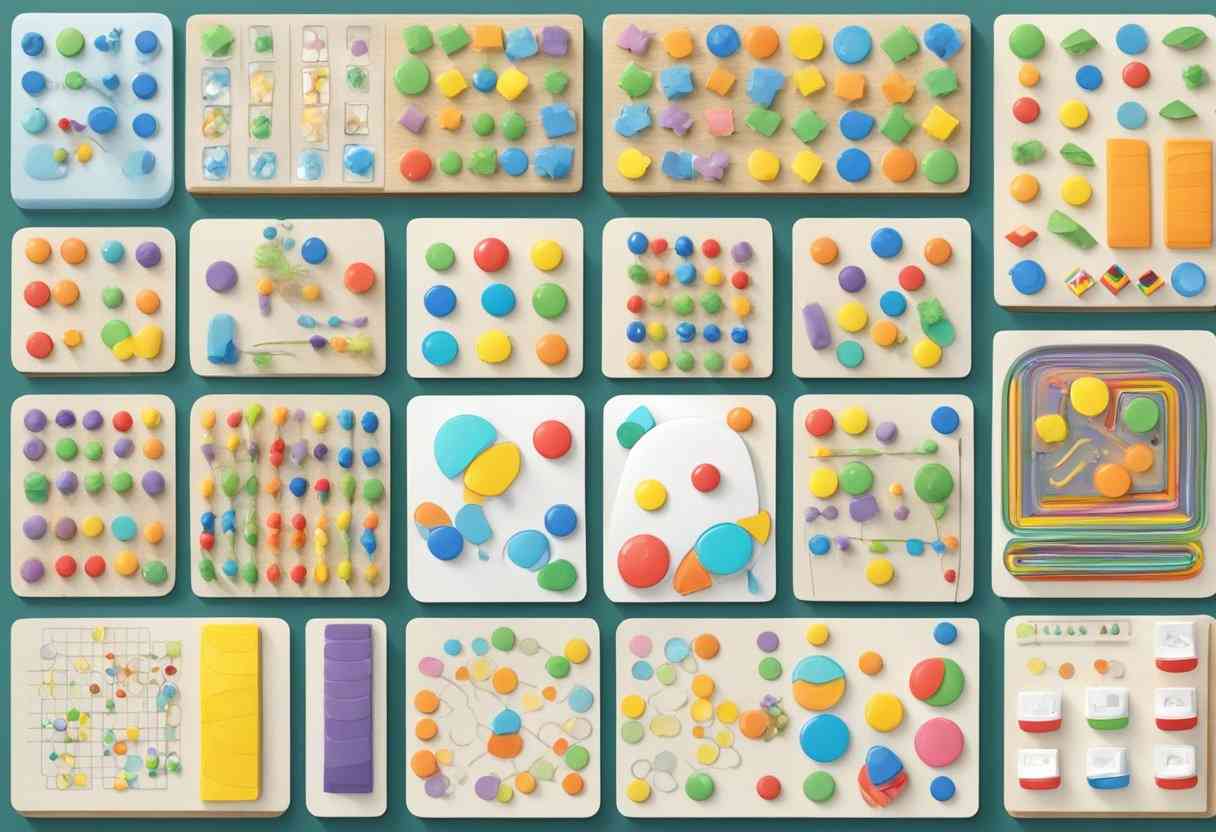Creating a sensory board for a child with autism can be a fun and engaging way to help them explore and process different sensations. Sensory boards are designed to provide a variety of tactile experiences that can help children with autism develop their sensory processing skills. By creating a sensory board tailored to your child’s interests and needs, you can help them engage with the world around them in a safe and controlled environment.
Sensory Boards Sensory boards are typically made up of a variety of different textures, materials, and objects that can be manipulated and explored by children with autism. These boards can help children develop their tactile, visual, and auditory processing skills, as well as improve their hand-eye coordination and fine motor skills. By providing a safe and controlled environment for sensory exploration, sensory boards can also help reduce anxiety and promote relaxation in children with autism.
Benefits of Sensory Boards for Children with Autism Creating a sensory board for your child with autism can provide a range of benefits. In addition to improving sensory processing skills, sensory boards can also help children develop their communication and socialization skills, as well as promote creativity and imagination. By incorporating a sensory board into your child’s daily routine, you can help them engage with the world around them in a meaningful and enjoyable way.
Key Takeaways
- Sensory boards provide a variety of tactile experiences that can help children with autism develop their sensory processing skills.
- Sensory boards can reduce anxiety and promote relaxation in children with autism.
- Creating a sensory board can help children develop their communication and socialization skills, as well as promote creativity and imagination.
What are Sensory Boards
Sensory boards, also known as busy boards or activity boards, are a great tool for children with autism. They are designed to provide sensory stimulation and help children develop fine motor skills, hand-eye coordination, and problem-solving skills. Sensory boards typically consist of a board with various objects attached to it, such as buttons, zippers, locks, latches, and switches.
The purpose of a sensory board is to provide a safe and controlled environment for children to explore and learn about different textures, sounds, and movements. It can also help children regulate their emotions and reduce anxiety by providing a calming and soothing effect.
Sensory boards can be customized to meet the needs and preferences of each child. They can be made from a variety of materials, such as wood, plastic, or metal, and can be designed to be portable or stationary. Some sensory boards also include lights, sounds, or other special features to enhance the sensory experience.
Sensory boards are a valuable tool for parents and caregivers to help children with autism develop their sensory and motor skills in a fun and engaging way.
Benefits of Sensory Boards for Children with Autism
Sensory boards can be a valuable tool for children with autism. Here are some of the benefits that sensory boards can provide:
1. Sensory Stimulation
Sensory boards can provide a variety of textures, colors, and sounds that can stimulate a child’s senses. This can be especially beneficial for children with autism who may have sensory processing difficulties. Sensory boards can help children develop their sensory processing skills and improve their ability to regulate their emotions.
2. Fine Motor Skills Development
Sensory boards often include activities that require fine motor skills, such as buttoning, zipping, and lacing. These activities can help children develop their hand-eye coordination and improve their fine motor skills. This can be especially important for children with autism who may have delays in their fine motor skills development.
3. Calming Effect
Sensory boards can also have a calming effect on children with autism. The sensory stimulation provided by the board can help children relax and feel more comfortable in their environment. This can be especially helpful in situations where a child may be feeling overwhelmed or anxious.
4. Educational Benefits
Sensory boards can also provide educational benefits. They can be used to teach children colors, shapes, and textures. They can also be used to teach children about cause and effect, as many sensory boards include activities that require a child to manipulate objects in order to produce a specific result.
Sensory boards can be a valuable tool for children with autism. They can provide sensory stimulation, help develop fine motor skills, have a calming effect, and provide educational benefits.
Materials Needed for Creating a Sensory Board
When creating a sensory board for a child with autism, it is important to choose the right materials to create a safe and engaging experience for the child. Here are some materials to consider when creating a sensory board:
Choosing the Board
The first step in creating a sensory board is choosing the right board. A sensory board can be made from a variety of materials, including wood, plastic, or metal. The board should be sturdy and able to support the weight of the sensory items that will be attached to it. It is also important to choose a board that is large enough to accommodate the desired sensory items.
Selecting Sensory Items
The sensory items that are added to the board should be selected based on the child’s individual needs and preferences. Some popular sensory items include:
- Textured fabrics (e.g. velvet, fur, silk)
- Different types of buttons and zippers
- Beads and other small objects to manipulate
- Mirrors and reflective surfaces
- Different types of lights (e.g. string lights, LED lights)
- Different types of sounds (e.g. bells, chimes, rattles)
When selecting sensory items, it is important to choose items that are safe and appropriate for the child’s age and developmental level. It is also important to consider the child’s sensory sensitivities and preferences when selecting items.
Creating a sensory board for a child with autism can be a fun and rewarding experience. By choosing the right board and selecting appropriate sensory items, parents and caregivers can create a safe and engaging sensory experience for their children.
Steps to Create a Sensory Board
Creating a sensory board for a child with autism can be a beneficial tool to help them explore their senses and improve their sensory processing skills. Here are the steps to create a sensory board:
Preparing the Board
The first step is to prepare the board. The board can be made of any material, such as wood, cardboard, or foam board. Make sure the board is large enough to fit all the sensory items that will be attached to it.
Arranging Sensory Items
Next, arrange the sensory items on the board. It is important to choose a variety of items that will stimulate different senses, such as touch, sight, and sound. Some examples of sensory items include:
- Velcro strips
- Zippers
- Buttons
- Beads
- Ribbons
- Different textured fabrics
- Mirrors
- Bells
- Sponges
- Pompoms
- Feathers
Arrange the items in a way that will be visually appealing and easy to access for the child. Consider using different colors and textures to make the board more interesting.
Securing the Items
Finally, secure the sensory items on the board. Use glue, Velcro, or double-sided tape to attach the items to the board. Make sure the items are securely attached to prevent them from falling off and becoming a choking hazard.
It is important to supervise the child while they are using the sensory board to ensure their safety. Encourage them to explore the different textures and sensations and provide positive reinforcement for their exploration.
Safety Considerations
When creating a sensory board for a child with autism, safety should be the top priority. Here are a few safety considerations to keep in mind:
1. Choose Safe Materials
Make sure to use materials that are safe for your child to touch and interact with. Avoid any materials that could be sharp, toxic, or pose a choking hazard. It’s also important to choose materials that are durable and won’t break easily.
2. Secure the Board
The sensory board should be securely fastened to the wall or another stable surface to prevent it from falling over. Make sure to use strong screws and anchors that can support the weight of the board and your child’s movements.
3. Supervision is Key
Always supervise your child while they are using the sensory board. This will ensure that they are safe and using the board properly. If you need to step away, make sure to take your child with you or have another adult supervise them.
4. Consider Your Child’s Sensory Needs
Every child with autism has different sensory needs. Some children may seek out sensory input, while others may find it overwhelming. Take your child’s sensory needs into consideration when designing the board and choose materials that will provide the right kind of input for them.
By keeping these safety considerations in mind, you can create a sensory board that is both fun and safe for your child with autism to use.
Incorporating the Sensory Board into Daily Activities
Once you have created a sensory board for your child with autism, it is important to incorporate it into daily activities. Here are some tips to help you do so:
- Place the sensory board in a prominent location where your child can easily access it. This will encourage them to interact with it throughout the day.
- Use the sensory board as a tool for sensory breaks. When your child is feeling overwhelmed or overstimulated, encourage them to take a break and interact with the sensory board.
- Incorporate the sensory board into playtime. Encourage your child to use the sensory board as part of their imaginative play, or to explore different textures and materials.
- Use the sensory board to help your child develop fine motor skills. Encourage them to manipulate the different objects on the board and to practice different grasping and pinching techniques.
- Make the sensory board a part of your child’s bedtime routine. Encourage them to interact with the sensory board before bed to help them relax and wind down.
By incorporating the sensory board into daily activities, you can help your child with autism develop important sensory and motor skills, while also providing them with a tool to help regulate their emotions and behavior.
Monitoring Progress and Making Adjustments
Once the sensory board is created, it is important to monitor the child’s progress and make any necessary adjustments. This will ensure that the child continues to be engaged and motivated by the board.
One way to monitor progress is to observe the child’s behavior while interacting with the board. Take note of which activities the child enjoys the most and which ones they seem less interested in. This information can be used to make adjustments to the board, such as adding or removing certain items.
Another way to monitor progress is to track the child’s sensory responses over time. Keep a log of the child’s reactions to each activity on the board, noting any changes or improvements. This can help identify areas where the child may need additional support or stimulation.
When making adjustments to the board, consider the child’s individual needs and preferences. For example, if the child is sensitive to certain textures, avoid adding items with those textures to the board. On the other hand, if the child responds well to certain sounds or colors, consider adding more items with those qualities.
It is important to remember that each child with autism is unique, and what works for one child may not work for another. Therefore, it may take some trial and error to find the right combination of activities for the child’s sensory board. With patience and persistence, however, the child can benefit greatly from this tool.
Final Thoughts
Creating a sensory board for a child with autism can be a fun and rewarding experience. By providing a variety of textures, sounds, and visual stimuli, a sensory board can help children with autism develop their sensory processing skills and improve their overall sensory integration.
When creating a sensory board, it is important to keep in mind the individual needs and preferences of the child. Some children may prefer certain textures or sounds, while others may find them overwhelming. It is also important to consider safety when selecting materials for the board and to supervise the child during use.
A sensory board can be a valuable tool for parents and caregivers of children with autism. By providing a safe and stimulating environment for sensory exploration, a sensory board can help children with autism develop important skills and improve their quality of life.










